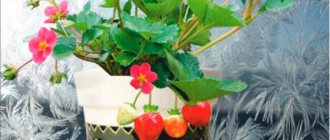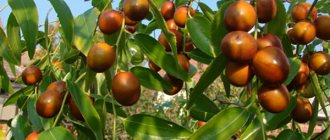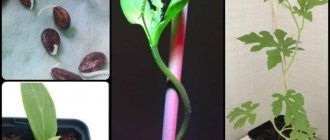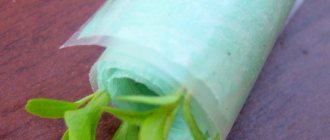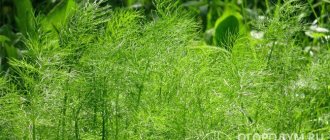Hello, dear summer residents and gardeners! Although today’s article will be of interest to those who are far from cultivating the land, but still grow flowers on the windowsill. That is, hello EVERYONE!
I don’t believe that there is even one among you who doesn’t like wild strawberries. But in winter you especially want it: it’s snowing outside, it’s white and white, and there are bright red juicy berries on the table, especially if it’s a New Year’s table! Of course, you can buy it, fortunately there is an abundance in supermarkets these days. But this berry will be completely tasteless - a pale shadow of summer pleasure. Yes, and it will cost a lot.
But why spend money? Growing strawberries on the windowsill all year round is not only possible, but also simple, even for novice plant growers. Get additional lighting, for example, phytolamps (inexpensive and accessible), free up space on the south or south-east windowsill, and go ahead, let's choose varieties!
The best strawberries to grow at home
Beardless remontant strawberry is a perennial plant. It can stay in one place for a long time, but each bush thickens quite quickly and the fruiting weakens, so the plant has to be replanted approximately every 4 years. Around the planted strawberries, many bushes grow from seeds that have fallen from overripe berries. In open ground, beardless strawberries bloom and bear fruit from June to November. In an apartment, strawberries can bear fruit almost all year round.
The berries of the plant are elongated, similar in size and appearance to wild strawberries, and have the same strong aroma. Bushes with numerous white flowers, green and red berries look very elegant. Beardless strawberries are more resistant to diseases and pests, in particular to weevils and nematodes.
Choosing a variety
Naturally, only repairable ones are suitable for us. Why? Regular varieties of strawberries bear fruit only once a year. The remontant variety can continuously produce berries for almost 10 months in a row, depending on the variety. Argument?
Now let's decide which varieties are more suitable for growing in an apartment. I propose to focus on those that perfectly lay new buds in neutral daylight hours (NSD varieties). For them, neither the time of day, nor the season, nor even the weather plays any role. And they can bear fruit literally for a whole year continuously. It goes without saying that such plants deplete faster, that is, their lifespan, as a rule, does not exceed two years.
Personally, I would recommend the Queen Elizabeth II variety. But there is an alternative: Queen Elizabeth, Roman F1, Tristan, Brighton, and many others.
Growing strawberries from seeds:
The undoubted advantage of this strawberry is that it can be grown from seeds and already in the first summer it will begin to bear fruit. You can propagate it by dividing the bush. The important thing is that it tolerates shade better than large-fruited strawberries, so it can be grown in flower pots on a balcony, loggia, or windowsill. When propagated by seeds, the plant does not split the variety in its offspring, so feel free to sow the seeds in February or early March in shallow containers approximately 5–7 cm high. The main condition is that they must be wide (for example, a herring jar is suitable).
Selection of material and its planting
The seed method is rarely used by amateur gardeners. It is long-lasting, therefore it is used mainly by breeders to develop new varieties. The mustache propagation method helps to preserve all the original characteristics. Preparing seedlings for planting in pots should be done in the fall. The seedlings obtained from the mustache will have grown by this time.
Rooted rosettes should be carefully examined and healthy, full-sized and large ones should be selected. The rosette is separated from the donor bush and excess leaves are removed from it. Planted in a prepared pot. After this, the bushes are left alone and lowered into the basement for 10-14 days.
Care and cultivation of strawberries at home:
The soil
should have a slightly acidic reaction. The plant is undemanding to soil, but it is best to prepare a mixture of peat, sand and sifted ash or chalk. Peat can be purchased at a gardening store. Fine river sand and chalk are sold along with construction products or in Home Improvement stores. All components are mixed in the following proportion: take a bag of sand (1–2 kg) and 2 cups of chalk (or a liter jar of sifted ash) onto a bucket of peat. I add another 1 teaspoon of powdered AVA universal fertilizer to the mixture. When using ash, you do not need to apply this fertilizer. If you don't have ash or AVA, use 1 tbsp. a spoonful of azofoska. Fill the container to the very top with this mixture, wet it well with water, and seal with a tablespoon. Before sowing very small seeds of any strawberry, bring some snow from the street, sprinkle it in a thin layer on the soil and compact it with a spoon. Now sow 2-3 seeds in each container. They are clearly visible in the snow, and you can always move them so that the crops are not too dense. It is better to immediately sow the seeds at a distance of about 2 cm from each other. All small seeds, not necessarily strawberry seeds, should not be buried in the soil. They require light to germinate. The snow, having melted, will pull the seeds halfway into the soil, and they will sprout well. It is important that the surface layer of soil does not dry out. To do this, it is best to place glass on top of the jar (not on the soil!) or put the jar in a plastic bag and place it in a warm place. As soon as the seedlings appear, remove the film or glass and move the container to the windowsill as close to the glass as possible, or illuminate the seedlings with a fluorescent lamp for 12 hours. The seedlings are tiny, they resemble small green dots on the ground. Water them with water along the edge of the jar using a teaspoon. If moisture gets on the cotyledon leaves, they will stick to the surface of the soil and will no longer be able to rise. You can moisten the soil with a pipette or water with a syringe through a needle inserted into the soil.
Reviews
– For home seedlings, it is better to take seeds of remontant strawberries, this will get rid of the mustache. But I use universal soil, and everything grows perfectly. But, of course, I carry out seed stratification as without it! I wrap the box with soil and seeds in polyethylene and put it in the refrigerator for a day. I usually have seedlings appear on the twelfth day.
Elena, Cockerels
– My seedlings did not sprout. It's my own fault. Now I understand that I simply covered the seeds heavily with soil, and nothing happened.
Vladimir, Lesnoy
– Strawberries in peat tablets – interesting, I’ll have to try them. Usually I just planted them in cups, but replanting them is still inconvenient, the roots get mixed up and are difficult to separate. I think you can put one seed per tablet.
Irina, Tula
– Very useful information, thank you! I didn’t know before that you could sow on snow. Need to try.
Ksenia, Tver
– My seedlings have started to dry out. Now I understand that I drove the heart of the sprout, the rosette, too deep into the ground. Corrected. The seedlings have come to life!
Nikolay, Sysert
Capricious, but so tasty, strawberries will delight gardeners with a good harvest if you care for them properly. Using a “greenhouse” on your home windowsill, you can grow strong, healthy seedlings, following the advice of experienced gardeners.
Health to you and your loved ones! Natalya Belokopytova.
Growing strawberry seedlings indoors
Strawberry seedlings
does not pick, but is simply thinned out when it grows 2-3 true leaves (therefore, sparse sowing is required). At this time, the plant begins to fall to one side under its own weight. They need to be pestered by raking the soil to the stem with a match and supporting the plant with a second match. Strawberry seeds can be sown in late August or early September. You can sow the seeds in a box, and then plant 2-3 plants from it in separate pots, when the seedlings have 4-5 true leaves. Since peat and sand do not contain nutrients, watering the seedlings must be combined with fertilizing as soon as seedlings appear and the plant switches to its own nutrition, having used up the entire supply of nutrients from the mother seed.
Planting seedlings
How to plant strawberries with seeds is described above, and the process of planting seedlings in the garden has its own characteristics:
- the seedlings must be strong and not damaged;
- The sprouts should have roots up to 5 cm and several leaves;
- the sprouts should not be affected by pests; such seedlings do not guarantee survival;
- It is better to plant in cloudy weather;
- pits for seedlings should have a depth of up to 12 cm;
- the distance between rows is up to 70 cm, between bushes - up to 25 cm.
The quality of the future harvest directly depends on the purchased seeds. In Moscow and the Moscow region, you can purchase seeds from trusted summer residents, and in the future, select several strawberries and select seeds from them.
Planted plants need good lighting and good ventilation of the bushes. You should not deepen the seedlings too much - this will lead to the growth point falling asleep after exposure to moisture.
Top dressing for growing strawberries at home
Feeding
can be made with complete mineral fertilizer. The solution should be weak (1 teaspoon per 3 liters of water). It is convenient to use Uniflor-bud (1 teaspoon per 3 liters of water) or, at worst, an ash extract. To do this, take a glass of ash, pour 1 liter of boiling water, leave overnight, strain and dilute in 5 liters of water. When watering you need to take 1 tbsp. a spoonful of solution for each liter of watering and fertilizing. If, when sowing directly into pots or transplanting seedlings into a separate container, you add granular AVA fertilizer to the soil (1 teaspoon per 3 pots), then you will not have to feed strawberries for 2-3 years. In general, strawberries eat little. It should not be overfed, otherwise a powerful bush will grow without berries. Water the bushes moderately. If you water too much, the roots will begin to rot, and small black flies will fly around the apartment. In winter, watering is even weaker. To make the berries larger, some of the flowers should be torn off.
Lighting
When choosing a windowsill where our berries will grow, choose one that receives a lot of sunlight. Mainly southern, south-eastern, western sides. As a last resort, you can use a forty-watt fluorescent lamp. For such purposes, there are special phyto lamps with o. At the same time, you must take into account that the lighting from such lamps is not pleasant to the eye. The plant must receive light baths for at least 12 hours a day, otherwise there will be no result. A small amount of light provokes a slowdown in growth. Measurement is important in this matter, because more than 14 hours of continuous lighting per day will not be beneficial.
Description
Strawberries are a fragrant, sweet berry that can be found in almost every garden. The unpretentious nature of the crop allows you to grow berries at home. Decorative bushes are planted not only to obtain a harvest, but also to decorate the site.
The berry reproduces well by seeds and rosettes on side shoots. Growing seedlings from seeds allows you to preserve all the characteristics of the variety. In particular, this method is used for remontant small-fruited varieties.
Strawberries are widely popular among gardeners because they are able to bear fruit throughout the entire summer season.
How to protect homemade strawberries from diseases and pests
If you follow the rules of agricultural cultivation, then you won’t need to protect the bushes at home.
If the room temperature is high and the air is dry, expect spider mites to appear. The pest attacks berries that are not yet ripe. Get rid of them with insecticides. From folk remedies - spray the affected bushes with garlic tincture.
The most common disease is powdery mildew. For prevention and treatment, a solution of the fungicide Fitosporin is used.
Planting seedlings in a permanent place
Strong seedlings are planted on the site in May, when the air temperature remains constant for a week. Sharp cold snaps destroy young plants.
The sprouts should have 6 leaves and look healthy.
The transplant must be carried out in three stages:
- Harden off the plant. Take it outside every day for 5-6 hours.
- Spray the seedlings with anti-stress plant a day before transplanting. For example, Epin.
- Replant the plants in the area.
After transplantation, it is necessary to continue caring for the crop. It is important to monitor soil moisture and regularly fertilize the plants.
